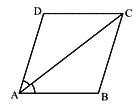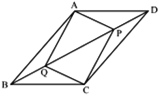Quadrilaterals
Exercise 8.1
1. If the diagonals of a parallelogram are equal, then show that it is a rectangle.
2. Show that the diagonals of a square are equal and bisect each other at right angles.
3. Diagonal AC of a parallelogram ABCD bisects ∠A (see Fig.). Show that:
(i) it bisects ∠C also,
(ii) ABCD is a rhombus.
4. ABCD is a rectangle in which diagonal AC bisects ∠A as well as ∠C. Show that:
(i) ABCD is a square
(ii) diagonal BD bisects ∠B as well as ∠D.
5. In parallelogram ABCD, two points P and Q are taken on diagonal BD such that DP = BQ (see Fig.). Show that:
(i) ΔAPD ≅ ΔCQB
(ii) AP = CQ
(iii) ΔAQB ≅ ΔCPD
(iv) AQ = CP
(v) APCQ is a parallelogram
6. ABCD is a parallelogram and AP and CQ are perpendiculars from vertices A and C on diagonal BD (see Fig.). Show that:
(i) ΔAPB ≅ ΔCQD
(ii) AP = CQ
7. ABCD is a trapezium in which AB || CD and AD = BC (see Fig.). Show that:
(i) ∠A = ∠B
(ii) ∠C = ∠D
(iii) ΔABC ≅ ΔBAD
(iv) diagonal AC = diagonal BD
[Hint :Extend AB and draw a line through C parallel to DA intersecting AB produced at E.]




